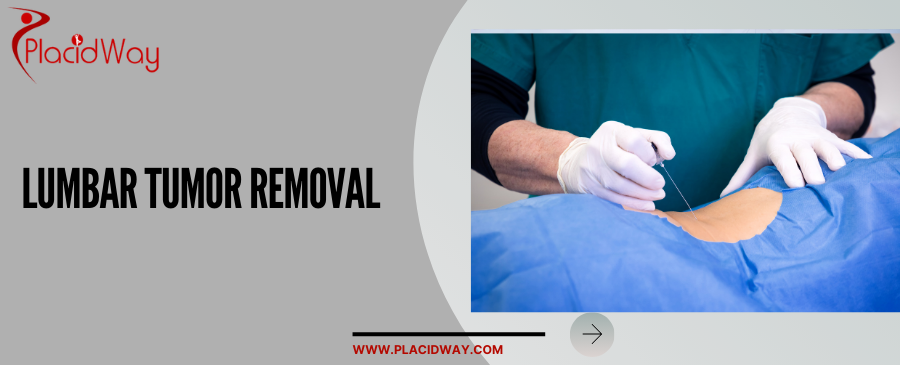
Navigating Lumbar Tumor Removal: Your Path to a Pain-Free Future
Facing a diagnosis of a lumbar spinal tumor can bring a flood of emotions and questions. At PlacidWay, we understand the anxieties and uncertainties that come with such a condition. Lumbar tumor removal is a critical surgical procedure designed to address growths in the lower part of your spine, the lumbar region, which can significantly impact your mobility, comfort, and overall well-being. Whether these tumors are benign (non-cancerous) or malignant (cancerous), they can exert pressure on the spinal cord and nerve roots, leading to debilitating pain, numbness, weakness, and other neurological deficits.
This comprehensive guide aims to illuminate the path forward, offering clarity on what lumbar tumor removal entails, from understanding the symptoms and causes to exploring treatment options, recovery expectations, and the compelling advantages of seeking this life-changing procedure through medical tourism. Our goal is to empower you with knowledge, connecting you to world-class medical facilities and expert surgeons globally, making your journey towards health and recovery as seamless and stress-free as possible. Many patients search for "spinal tumor treatment options," "relief from back tumor pain," or "where to get safe spinal surgery." This content is designed to answer these questions and more, guiding you toward informed decisions.
What are the common symptoms of a lumbar spinal tumor?
Recognizing the signs of a lumbar spinal tumor early can be crucial for timely intervention. Many patients initially dismiss their discomfort as common back pain, searching for "why does my back hurt so much?" However, symptoms related to spinal tumors often have distinct characteristics. The most prevalent symptom is pain, specifically in the lower back, which might:
- Be persistent and progressive, not relieved by rest.
- Worsen at night or upon waking.
- Radiate to other parts of the body, such as the hips, legs, or feet (radicular pain).
- Be accompanied by numbness, tingling, or weakness in the legs, a sensation often described as "pins and needles."
As the tumor grows and exerts more pressure on the spinal cord or nerve roots, additional symptoms may emerge, including:
- Difficulty walking or maintaining balance.
- Loss of sensation in the legs, feet, or perineal area.
- Muscle weakness or loss of muscle function in the legs.
- Changes in bowel or bladder function, such as incontinence or difficulty urinating (a serious sign known as cauda equina syndrome).
- Scoliosis or other spinal deformities if the tumor affects bone growth.
It's important to differentiate these symptoms from routine back pain. If you experience any of these persistent or worsening signs, especially neurological symptoms, it's vital to seek medical attention promptly. Many patients ask, "What are the signs of a tumor in the spine?" and "When should I worry about my back pain?" The key is persistence and associated neurological changes.
What causes lumbar spinal tumors and what are the risk factors?
Spinal tumors are generally categorized into two main types: primary and metastatic. Understanding their origins can help in diagnosis and treatment planning.
Primary Spinal Tumors:
These tumors originate within the spine itself, including the spinal cord, nerve roots, meninges (membranes surrounding the spinal cord), or the vertebrae (bones of the spine). The exact causes of primary spinal tumors are often unknown, but some are linked to genetic factors. Conditions like Neurofibromatosis 2 (NF2) and Von Hippel-Lindau disease are known to increase the risk of certain types of spinal tumors, such as schwannomas or ependymomas. Patients often ask, "Are back tumors genetic?" and for some types, there is a hereditary link.
Metastatic Spinal Tumors:
Much more common than primary tumors, metastatic spinal tumors occur when cancer cells spread from a primary tumor located elsewhere in the body to the spine. Cancers that frequently metastasize to the spine include:
- Lung cancer
- Breast cancer
- Prostate cancer
- Kidney cancer
- Thyroid cancer
- Multiple myeloma
The primary risk factor for metastatic spinal tumors is a prior diagnosis of cancer. Other general risk factors for cancer, such as age, exposure to certain chemicals, or a weakened immune system, can indirectly increase the likelihood of developing spinal metastases.
For both types, cellular mutations lead to uncontrolled growth, forming a tumor. While lifestyle factors aren't directly linked to primary spinal tumors, maintaining overall health and regular cancer screenings are important for early detection, especially if you have a history of cancer.
What types of procedures are available for lumbar tumor removal?
The choice of surgical procedure for lumbar tumor removal depends on several factors: the tumor's size, location, type (benign or malignant), the extent of spinal cord compression, and the patient's overall health. Surgeons aim to remove as much of the tumor as safely possible while preserving neurological function and spinal stability. Patients often search for "minimally invasive spinal tumor surgery" or "open back tumor removal."
1. Open Surgical Approaches:
- Laminectomy: This is a common open surgical technique where a portion of the vertebral bone (lamina) is removed to access the tumor. It's often used for tumors located within the spinal canal (intradural, intramedullary, or extradural). The goal is decompression and tumor excision.
- Corpectomy: When a tumor affects the vertebral body, a corpectomy involves removing part or all of the affected vertebral body. This procedure often requires subsequent spinal reconstruction and fusion using bone grafts or implants to stabilize the spine.
- En Bloc Resection: For certain aggressive tumors, the surgeon may remove the tumor and a margin of healthy tissue in one piece. This is a complex procedure often requiring significant reconstruction.
2. Minimally Invasive Spinal Surgery (MIS):
MIS techniques use smaller incisions, specialized instruments, and advanced imaging guidance. These approaches can lead to less muscle damage, reduced blood loss, shorter hospital stays, and quicker recovery times. They are suitable for certain types and locations of tumors, though not all. Patients often ask, "Is minimally invasive spinal tumor surgery effective?" For appropriate cases, it can be highly effective.
3. Spinal Stabilization and Fusion:
Often, after tumor removal, especially with corpectomy or extensive laminectomy, the spine may become unstable. Spinal fusion involves joining two or more vertebrae permanently to restore stability, often using metal rods, screws, and bone grafts.
4. Adjunctive Therapies:
Surgery is frequently combined with other treatments, particularly for malignant tumors:
- Radiation Therapy: Used to shrink tumors before surgery, destroy residual tumor cells after surgery, or as a primary treatment if surgery isn't possible.
- Chemotherapy: Systemic treatment for cancerous tumors, particularly those that have metastasized.
- Stereotactic Radiosurgery (SRS): A highly focused form of radiation therapy that delivers precise, high doses of radiation to the tumor while minimizing exposure to surrounding healthy tissue.
A multidisciplinary team, including neurosurgeons, oncologists, and radiation oncologists, collaborates to determine the most effective treatment plan for each patient.
Who is eligible for lumbar tumor removal surgery?
Determining eligibility for lumbar tumor removal is a complex process involving a thorough evaluation by a team of specialists. The primary goal of surgery is to improve quality of life, alleviate neurological deficits, and, if possible, achieve a cure. Patients frequently ask, "Am I a candidate for spinal tumor surgery?" or "When is back tumor surgery necessary?"
Key factors considered for eligibility include:
- Neurological Deficit: If the tumor is causing significant compression of the spinal cord or nerve roots, leading to severe pain, numbness, weakness, or bowel/bladder dysfunction, surgery is often indicated to prevent irreversible damage.
- Spinal Instability: Tumors that have damaged the vertebral bones can lead to spinal instability, requiring surgical intervention for stabilization and pain relief.
- Biopsy Confirmation: In many cases, a biopsy is performed to determine if the tumor is benign or malignant, which heavily influences treatment strategy.
- Tumor Type and Location: Some tumors are more amenable to surgical removal than others. For example, meningiomas or schwannomas (often benign) can frequently be completely removed, while highly infiltrative malignant tumors might require a different approach.
- Overall Health and Life Expectancy: The patient's general health, age, and presence of other medical conditions (comorbidities) are crucial. For metastatic tumors, the prognosis of the primary cancer is a major consideration. If life expectancy is very limited, less invasive options or palliative care might be preferred.
- Response to Other Therapies: If radiation or chemotherapy has not effectively controlled tumor growth or symptoms, surgery may be considered.
- Quality of Life: Even if a tumor is benign, if it significantly impairs a patient's quality of life due to pain or neurological issues, surgery may be recommended.
A multidisciplinary team, including neurosurgeons, orthopedic spine surgeons, oncologists, and radiation oncologists, will review imaging (MRI, CT), biopsy results, and the patient's clinical presentation to make an individualized treatment recommendation.
What should I expect during recovery after lumbar tumor removal?
Recovery from lumbar tumor removal is a journey that varies greatly depending on the type and extent of surgery, the patient's pre-operative condition, and their overall health. Patients often wonder, "How long is recovery from back tumor surgery?" or "What is rehabilitation like after spinal tumor surgery?"
Immediate Post-operative Period (Hospital Stay):
- Hospital Stay: Typically, patients remain in the hospital for 3 to 7 days, sometimes longer for more complex procedures or if spinal fusion was performed.
- Pain Management: Pain is expected after surgery and will be managed with medication, often delivered intravenously initially, then orally.
- Early Mobilization: Under the guidance of physical therapists, you will be encouraged to sit up and take short walks soon after surgery to prevent complications like blood clots and pneumonia, and to begin regaining strength.
- Wound Care: The surgical incision will be monitored for signs of infection. You'll receive instructions on how to care for it after discharge.
Intermediate Recovery (Weeks to Months):
- Physical Therapy: A cornerstone of recovery. You will likely continue physical therapy, either in-patient or out-patient, to regain strength, flexibility, and balance. This is crucial for "lumbar tumor surgery rehabilitation."
- Activity Restrictions: You will have strict restrictions on lifting, bending, and twisting for several weeks or months to protect your healing spine.
- Pain and Numbness: Some residual pain, numbness, or tingling may persist for a while as nerves heal. This gradually improves over time.
- Energy Levels: It's common to feel tired and fatigued during the initial weeks of recovery. Pacing yourself and getting adequate rest is vital.
Long-term Recovery:
- Full Recovery: Can take anywhere from 3 months to over a year, especially if spinal fusion was performed.
- Follow-up Appointments: Regular check-ups with your surgeon and oncologist (if applicable) are essential to monitor your recovery and detect any recurrence.
- Emotional Support: Dealing with a spinal tumor diagnosis and surgery can be emotionally challenging. Seeking support from family, friends, or support groups can be very beneficial.
Adhering to your surgeon's and therapist's instructions is paramount for a successful and safe recovery.
What are the potential risks and side effects of lumbar tumor surgery?
While lumbar tumor removal surgery offers significant benefits, like any major surgical procedure, it carries potential risks and side effects. Patients often ask, "Is spinal tumor surgery dangerous?" or "What are the complications of back tumor removal?" While modern surgical techniques and technologies have greatly reduced these risks, it's essential to be aware of them.
- Infection: Any surgery carries a risk of infection at the incision site or deeper within the spine. Antibiotics are typically given before and after surgery to minimize this risk.
- Bleeding: Blood loss during surgery can occur, sometimes requiring transfusions.
- Nerve Damage: The most significant risk, as the spine houses vital nerves. Damage to the spinal cord or nerve roots can lead to new or worsened weakness, numbness, altered sensation, or even paralysis (though rare with expert surgeons). Intraoperative neuromonitoring helps to reduce this risk.
- Cerebrospinal Fluid (CSF) Leak: The spinal cord is surrounded by CSF. A tear in the dura (the membrane covering the spinal cord) can lead to a CSF leak, which may cause headaches or require further repair.
- Spinal Instability: Removal of bone or tissue can sometimes lead to instability of the spine, which may necessitate a spinal fusion procedure (or re-fusion) to stabilize the affected segment.
- Anesthesia Risks: Reactions to anesthesia, including respiratory or cardiac issues, are possible.
- Blood Clots: Deep vein thrombosis (DVT) in the legs or pulmonary embolism (PE) in the lungs are potential complications, minimized by early mobilization and sometimes blood thinners.
- Recurrence: Depending on the tumor type, there's always a risk of the tumor growing back, especially for malignant or incompletely resected tumors.
- Persistent Pain: While surgery aims to relieve pain, some patients may experience ongoing or new pain.
Your surgical team will discuss these risks with you in detail, ensuring you are fully informed before proceeding with the surgery. Choosing an experienced surgeon and a reputable facility significantly helps in mitigating these risks.
How does the cost of lumbar tumor removal compare worldwide?
For many patients, the cost of lumbar tumor removal is a major concern, particularly when facing high healthcare expenses in their home country. This leads many to search for "spinal tumor surgery cost abroad" or "affordable back tumor treatment." The price can fluctuate wildly based on the country, the complexity of the tumor, the specific surgical technique used, the length of hospital stay, and the surgeon's fees and facility's reputation.
Here’s a general comparison of estimated costs for lumbar tumor removal surgery across different regions:
| Country | Estimated Cost (USD) | Key Advantages for Patients |
|---|---|---|
| United States | $60,000 - $150,000+ | Advanced technology, highly skilled surgeons, but very high costs and potential wait times. |
| United Kingdom | $50,000 - $100,000+ | High standards, but long waiting lists in public healthcare, private options are expensive. |
| Germany | $40,000 - $80,000+ | Renowned for precision medicine, excellent infrastructure, highly trained specialists. |
| India | $18,000 - $45,000+ | Significant cost savings, JCI-accredited hospitals, English-speaking staff, experienced surgeons. |
| Turkey | $20,000 - $50,000+ | Modern facilities, competitive pricing, strategic location between Europe and Asia. |
| Mexico | $25,000 - $55,000+ | Close proximity for North American patients, growing medical tourism infrastructure, good value. |
| Thailand | $22,000 - $48,000+ | Excellent patient care, luxurious facilities, popular destination for health and wellness. |
These figures are estimates and can vary based on individual case specifics, surgeon's fees, and hospital charges. Medical tourism offers a compelling solution for those seeking "affordable spinal tumor surgery destinations" without compromising on the quality of care.
Why should I consider traveling abroad for lumbar tumor removal?
The decision to travel abroad for a complex procedure like lumbar tumor removal is significant, but it can present numerous advantages, leading many to explore "benefits of overseas back surgery."
- Significant Cost Savings: As highlighted in the cost comparison, the price difference for the same high-quality procedure can be dramatic. Patients can save tens of thousands of dollars, making life-saving surgery accessible.
- Access to Specialized Care: Medical tourism allows you to tap into a global network of top-tier neurosurgeons and spine specialists who might not be readily available or affordable in your home country. These experts often have vast experience with specific or rare tumor types.
- Reduced Waiting Times: In some national healthcare systems, long waiting lists for specialist consultations and surgery can delay critical treatment, potentially allowing the tumor to grow or symptoms to worsen. Traveling abroad often means you can schedule your surgery much sooner.
- State-of-the-Art Facilities and Technology: Many international hospitals catering to medical tourists are equipped with the latest surgical technology, diagnostic tools, and intensive care units, ensuring a high standard of care.
- Privacy and Anonymity: For some, undergoing a major medical procedure away from their immediate social circle offers a sense of privacy and the opportunity to recover without constant scrutiny.
- Personalized Patient Support: Reputable medical tourism facilitators, like PlacidWay, provide comprehensive support, including travel arrangements, accommodation, language assistance, and coordination of medical appointments, easing the burden on patients and their families.
The core motivation for many is the pursuit of effective, affordable, and timely treatment, particularly for a condition as serious as a lumbar spinal tumor. Exploring "medical tourism for spinal tumors" means prioritizing your health and well-being with a global perspective.
Which countries offer the best value for spinal tumor surgery?
When searching for "top countries for spinal tumor removal" or "affordable spinal surgery destinations," several nations consistently emerge as leaders in medical tourism due to their excellent healthcare infrastructure, skilled professionals, and competitive pricing.
- India: A global hub for medical tourism, India boasts numerous JCI-accredited hospitals with state-of-the-art technology and highly experienced neurosurgeons. English is widely spoken in medical settings, and comprehensive packages, including accommodation and transfers, are common. The cost savings are substantial.
- Turkey: Positioned at the crossroads of Europe and Asia, Turkey has invested heavily in modernizing its healthcare sector. Turkish hospitals offer advanced surgical techniques, world-class specialists, and recovery options, often with shorter wait times and at a fraction of Western costs.
- Mexico: Particularly attractive for North American patients due to its proximity, Mexico offers high-quality spine surgery with experienced surgeons, many of whom are US-trained. Its growing medical tourism industry provides a more accessible and affordable option for complex procedures.
- Thailand: Known for its exceptional hospitality and luxurious private hospitals, Thailand provides a holistic healing experience. Patients receive top-tier medical care in environments designed for comfort and recovery, making it popular for those seeking "quality back surgery overseas."
- Germany: While generally higher in cost than Asian or Latin American options, Germany is renowned for its precision medicine, advanced diagnostics, and highly specialized surgeons. It appeals to patients seeking the highest standards of European medical care for complex neurological conditions.
These countries not only provide excellent medical care but often combine treatment with attractive recovery environments, ensuring a comfortable and comprehensive healing experience.
How to ensure safety and quality when choosing spinal tumor surgery abroad?
The most important aspect of medical tourism, especially for a serious procedure like lumbar tumor removal, is ensuring patient safety and the quality of care. Many patients understandably ask, "How to find a safe spinal surgeon abroad?" or "What about quality control for overseas medical care?" Here are essential steps:
- Verify International Accreditation: Look for hospitals accredited by recognized international bodies, such as the Joint Commission International (JCI). JCI accreditation signifies that a hospital meets rigorous international standards for patient safety and quality of care.
- Research Surgeon Credentials and Experience: Ensure your surgeon is board-certified, has extensive experience specifically in spinal tumor surgery, and ideally, a specialty in neurosurgery or orthopedic spine surgery. Inquire about their success rates and volume of similar procedures performed.
- Read Patient Reviews and Testimonials: Seek out feedback from previous international patients who have undergone similar procedures at the hospital or with the surgeon you are considering. Authentic reviews can offer valuable insights.
- Request Comprehensive Information and Consultations: Before committing, request detailed treatment plans, cost breakdowns, and schedule virtual consultations with the medical team. This allows you to ask questions, assess their communication style, and understand the proposed treatment.
- Utilize a Reputable Medical Tourism Facilitator: Companies like PlacidWay specialize in connecting patients with vetted, high-quality international healthcare providers. We perform due diligence on hospitals and surgeons, help with logistics, and provide ongoing support, ensuring a smoother and safer experience.
- Check Technology and Equipment: Confirm that the hospital uses modern diagnostic and surgical equipment, including advanced imaging (MRI, CT), intraoperative monitoring, and minimally invasive tools if applicable.
- Understand the Continuum of Care: Inquire about post-operative care, rehabilitation services, and follow-up protocols. A good facility will have a clear plan for your recovery and long-term monitoring.
- Insurance and Emergency Preparedness: Understand what your travel insurance covers and what emergency protocols are in place should an unforeseen complication arise.
By taking these proactive steps, you can significantly enhance the safety and quality of your lumbar tumor removal experience abroad.
What are patient success stories from abroad for spinal tumor surgery?
Stories of successful recovery and improved quality of life are powerful motivators for patients considering spinal tumor surgery abroad. While individual outcomes vary, the narratives of those who've chosen this path often highlight key themes:
- Relief from Chronic Pain: Many patients arrive with debilitating, constant back pain, nerve pain, and neurological deficits. Post-surgery, they often report dramatic relief, regaining the ability to perform daily activities without constant discomfort. "I can finally walk without pain again," is a common sentiment.
- Restored Neurological Function: Individuals who suffered from numbness, weakness, or even partial paralysis due to tumor compression frequently describe significant recovery in their motor and sensory functions. One patient might say, "My leg strength is back, and the tingling is gone," after searching for "patient reviews spinal tumor surgery abroad."
- Access to Timely, Expert Care: For patients facing long wait lists at home, traveling abroad provides swift access to highly skilled surgeons. A patient from a country with long wait times might share, "I got my surgery within weeks of diagnosis, which was critical for my peace of mind and prognosis."
- Exceptional Patient Experience: Beyond the medical outcome, many patients praise the personalized attention, cultural sensitivity, and comprehensive support services provided by international hospitals and facilitators. "The care felt truly holistic, from the medical team to the recovery environment," a patient might recount.
- Financial Relief: The substantial cost savings are a consistent highlight. Patients often express profound gratitude for receiving world-class treatment that would have been financially impossible in their home countries. "This surgery gave me my life back, and I didn't have to go bankrupt doing it," is a common sentiment.
These success stories underscore the viability and benefits of seeking lumbar tumor removal abroad, offering hope and practical solutions for those in need of specialized spinal care. PlacidWay connects you to these life-changing opportunities, allowing you to focus on healing and recovery.
Take the Next Step with PlacidWay
Ready to explore treatment options abroad? Discover top clinics, compare prices, and get a free quote tailored to your needs with PlacidWay.
Affordable Spine Surgery | Best Spine Surgery Abroad










Share this listing